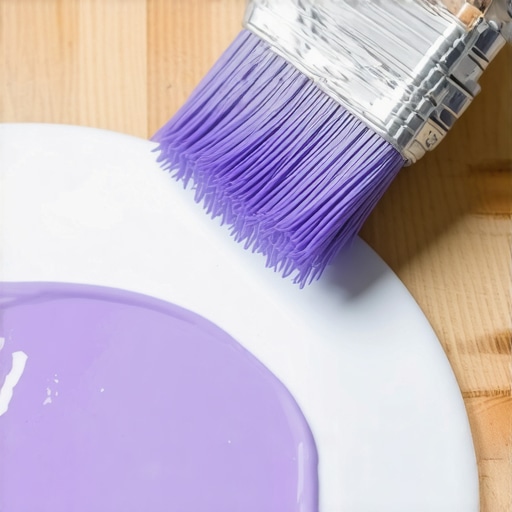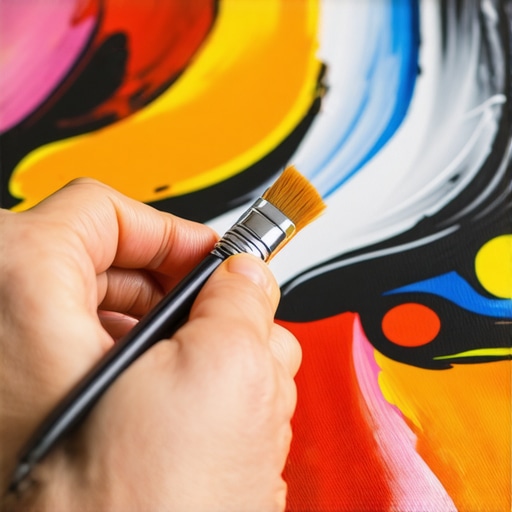Discovering the Magic of UV Protective Glazing in My Home Projects
As someone passionate about home decor and DIY crafts, I was always looking for ways to preserve the beauty of my artworks and decorative pieces. My journey began when I realized that sunlight could significantly fade and damage my cherished wall art and handcrafted items. That’s when I stumbled upon the concept of UV protective glazing. This innovative solution not only shields my masterpieces from harmful UV rays but also adds a glossy, professional finish that elevates the overall appearance.
My First Experience with Embeds in Home Decor
One of my favorite projects was embedding small glass fragments into resin to create a personalized tabletop. The process was incredibly satisfying, and I loved how the embedded pieces told a story of my travels and memories. Embeds are such a creative way to make home decor uniquely yours. I found that combining embedded objects with UV protective glazing ensures their longevity and keeps the colors vibrant over time.
Why I Switched to UV Protective Glazing for My Art Pieces
After experimenting with various DIY techniques, I learned that DIY home decor ideas benefit greatly from high-quality protective coatings. The UV protective glazing I chose is transparent, durable, and resistant to weathering. It’s perfect for sealing paintings, photographs, and even delicate embedded crafts. I noticed a marked difference in the preservation of my art, which motivated me to explore more creative ways to incorporate this technology into my projects.
How to Incorporate Embeds and UV Glazing into Unique Home Projects
Integrating embeds into resin or glass art is surprisingly straightforward once you get the hang of it. I recommend experimenting with different materials like shell fragments, metal charms, or pressed flowers. When it comes to sealing, I prefer applying multiple thin layers of UV protective glaze, allowing each to cure thoroughly. This not only enhances durability but also provides a beautiful, glossy finish that makes the embeds pop. If you’re curious about advanced techniques, I suggest exploring creative DIY crafts for inspiration.
What are the best practices to ensure embeds stay secure and vibrant over time?
One tip I found invaluable is to use a clear adhesive before embedding objects into resin. This prevents shifting during curing. Additionally, choosing UV-resistant glaze helps prevent discoloration. Remember to work in a dust-free environment and follow manufacturer instructions for curing times. For more detailed guidance, the expert resources are a treasure trove of tips.
Have you tried combining embeds with UV protective glazing in your projects? I’d love to hear your experiences and ideas! Feel free to share your thoughts in the comments or explore more creative solutions to elevate your home decor.
Unlocking the Secrets of UV Protective Glazing for Your DIY Art and Home Projects
As a seasoned DIY enthusiast and home decor expert, I understand the importance of protecting your creative investments. UV protective glazing is a game-changer for anyone looking to preserve the vibrancy and longevity of their artworks, photographs, and embedded crafts. This clear, durable coating acts as a shield against harmful ultraviolet rays, which can cause fading and deterioration over time, especially in areas with significant sunlight exposure.
In my own projects, I’ve found that applying UV protective glaze not only extends the lifespan of my pieces but also imparts a sleek, professional finish. Whether sealing a painted canvas or a resin tabletop embedded with sentimental objects, this glazing provides a glossy, weather-resistant layer that keeps your creations looking fresh for years. For those interested in expanding their DIY skills, exploring home decor ideas can inspire innovative ways to incorporate UV protection into your projects.
How to Use UV Protective Glazing in Your Creative Workflow
Applying UV protective glazing is straightforward, but attention to detail ensures the best results. Start by cleaning the surface thoroughly to remove dust and oils. Use a high-quality brush or spray, depending on the product type, and apply multiple thin layers, allowing each to cure completely before adding the next. This technique guarantees an even, durable finish that enhances the depth and gloss of your artwork or craft.
For embedded crafts, such as resin pieces with pressed flowers or metal charms, sealing with UV-resistant glaze helps preserve colors and prevents yellowing or discoloration. When working with larger projects, like a custom tabletop, consider using a spray application to achieve a smooth, seamless coating. If you want to learn more advanced techniques, I recommend exploring creative DIY crafts for inspiration and expert tips.

What strategies can I implement to ensure comprehensive UV protection without compromising the visual appeal of my projects?
One effective approach is to select glazing products with high UV resistance ratings, specifically designed for art and outdoor use. Combining multiple thin coats rather than a single thick layer enhances durability and gloss. Additionally, positioning your artworks away from direct sunlight or using UV-filtering glass in frames can further extend their vibrancy. Regular maintenance, such as cleaning the glazed surface with a soft cloth and avoiding harsh chemicals, also plays a crucial role in preservation.
For more detailed guidance on maintaining and restoring your DIY projects, the expert resources provide invaluable insights into advanced preservation techniques.
Have you experimented with UV protective coatings in your creative projects? Share your experiences or ask questions in the comments. If you’re eager to explore more ways to enhance your home decor and protect your crafts, check out our collection of home improvement tips for innovative DIY ideas that stand the test of time.
Deepening the Connection Between UV Protection and Artistic Integrity
As I delved further into the world of UV protective glazing, I realized that the nuances of application could dramatically influence the longevity and appearance of my works. It’s not just about choosing the right product but understanding how factors like curing time, layer thickness, and environmental conditions interplay to achieve a flawless finish. For instance, I learned that applying multiple thin coats, instead of a single thick layer, allows for better UV resistance and minimizes imperfections, which is a lesson I now incorporate into every project.
My Journey into Advanced Techniques and Material Compatibility
Exploring beyond basic applications, I experimented with different types of UV-resistant coatings—sprays, brushes, and even dips. Each method offers distinct advantages; sprays provide a smooth, even layer ideal for large surfaces, while brush-on glazes afford more control for detailed work. An insight I gained from my experience is ensuring compatibility between the glaze and underlying materials—resin, wood, or paint—to prevent adverse reactions like clouding or yellowing over time. The key is thorough research and testing, especially when combining embedded objects with delicate surfaces.
Addressing the Complexities of UV Protection in Outdoor vs. Indoor Environments
One of my more challenging projects involved outdoor garden art, where exposure to harsh sunlight tested the resilience of my coatings. I found that selecting UV-resistant products rated specifically for outdoor use made a significant difference. Additionally, integrating physical UV filters—like UV-protective glass or acrylic in framing—complements the glazing and extends the lifespan of artwork. This multi-layered approach mirrors the complexity of real-world preservation, reminding me that no single solution is sufficient alone. I encourage fellow DIY enthusiasts to consider environmental factors holistically when planning their projects.
What Are the Subtle Artistic Impacts of UV Glazing That Often Go Unnoticed?
One aspect I discovered through personal experimentation is how UV glazing influences the visual depth and gloss of artworks. A well-applied layer can enhance color vibrancy and add a subtle luminescence, elevating the piece’s aesthetic appeal. However, too thick or uneven layers can obscure fine details or create glare, detracting from the artwork’s intended effect. Balancing protective qualities with artistic vision requires patience and a keen eye for detail. It’s akin to a painter layering varnish—they must understand how each coat alters the final image. For those interested in mastering these subtleties, I recommend exploring advanced tutorials on creative DIY crafts.

How Can I Integrate UV Protection Seamlessly Into My Creative Workflow?
Incorporating UV protective measures into my projects became a natural part of my process once I understood the importance of planning ahead. From selecting the right coating during the initial stages of art creation to scheduling curing times, each step contributes to a cohesive workflow. I also began documenting my techniques, which helped me refine my approach over time. For example, I now always test different application methods on scrap pieces before committing to a final project. This practice reduces errors and ensures consistency, especially when working on multiple pieces or large installations.
If you’re eager to elevate your DIY craft game and protect your masterpieces, exploring detailed guides on preservation techniques can provide valuable insights. Remember, the key to successful UV protection is patience, precision, and understanding the material science behind the coatings.
Mastering the Art of UV-Resistant Finishes for Professional-Grade Outcomes
In my extensive journey through DIY artistry, I discovered that the key to truly elevating my projects lies in understanding the intricacies of UV-resistant coatings. These specialized finishes not only preserve the vibrancy of my artworks but also enhance their tactile appeal. Achieving a flawless, durable layer requires a nuanced approach—balancing layer thickness, curing environment, and product compatibility. For example, I often use high-grade UV-resistant sprays that cure in controlled conditions, ensuring an even, gloss-rich surface that elevates the visual depth of my pieces.
Integrating Multi-Layered UV Protection for Outdoor Art Installations
When working on outdoor projects, I learned that a single protective layer is insufficient. Instead, a multi-layered approach, combining UV-resistant paints, sealants, and physical UV barriers like acrylic covers, creates a comprehensive defense against sun damage. This layered strategy was inspired by research from the DIY creative solutions, emphasizing that environmental factors demand a holistic protection plan. The result is art that withstands the elements without compromising aesthetic integrity.
What Are the Cutting-Edge Materials for High-Performance UV Protection in DIY Art?
Exploring the frontier of materials science, I found that advancements like nano-ceramic coatings and photochromic films are revolutionizing UV protection. These materials offer superior transparency, self-healing properties, and enhanced durability. For instance, applying a nano-ceramic layer over my resin crafts has significantly increased their resistance to yellowing and surface degradation. Staying updated with the latest innovations, such as those documented in the advanced polymer techniques, ensures my work remains at the forefront of quality and longevity.
How Can I Tailor UV Protection Strategies to Different Materials and Artistic Styles?
Adapting UV protection to various substrates—be it resin, wood, or textiles—requires a tailored approach. For delicate textiles, I prefer breathable, UV-blocking sprays that do not alter texture, while robust epoxy resins benefit from high-gloss, multi-coat sealants. Artistic style also influences my choice; minimalist pieces often require subtle, matte finishes, whereas vibrant, layered works benefit from high-gloss UV coatings that amplify color depth. Experimentation and thorough testing on scrap materials are essential, and consulting resources like expert preservation techniques guides my process.
Engaging with advanced UV protection strategies has transformed my approach from basic sealing to sophisticated preservation, allowing my art to thrive in diverse environments. I encourage fellow creators to delve into these techniques, experimenting with innovative materials and layered applications to achieve professional results. Your projects deserve nothing less than the best in longevity and aesthetic excellence—embrace the challenge and elevate your craft today!
Things I Wish I Knew Earlier (or You Might Find Surprising)
The Subtle Power of Thin Coats
One surprise I discovered was how critical applying multiple thin layers of UV protective glazing is for achieving durability and a flawless finish. I used to rush through coatings, thinking thicker layers would be better, but I learned patience makes all the difference. This insight transformed my projects into professional-looking masterpieces that withstand time.
Materials That Play Well Together
Not all glazes are compatible with every surface or embedded object. My experimentation taught me to do thorough testing beforehand, especially when working with resin or delicate wood. Knowing which products work harmoniously helps prevent issues like clouding or yellowing, saving me time and frustration.
Environmental Factors Matter
Sunlight exposure and outdoor weather conditions dramatically influence how well UV protection works. I realized that outdoor projects require specialized UV-rated products and even physical barriers like UV-filtering glass. Thinking about the environment early on helps me craft pieces that last and look stunning over time.
Visual Impact of Glazing
Applying UV glaze can subtly enhance color vibrancy and add a professional gloss, but too much or uneven application can cause glare or obscure details. Achieving a perfect balance takes practice but pays off with a visually striking result that elevates my art and crafts.
Planning Is Key
Incorporating UV protection into my workflow from the start—selecting the right products, scheduling curing, and testing—makes the process smoother and more consistent. This proactive approach saves me time and ensures each piece is protected and beautiful.
Resources I’ve Come to Trust Over Time
- DIY Network’s Home Improvement Section — Their expert tutorials and product reviews helped me understand the nuances of UV coatings. I recommend it for reliable guidance.
- ArtResin’s Official Website — Their technical datasheets and application tips are invaluable for working with embedded crafts and resin art, making sure I get the best results.
- Creative Live’s DIY Art Courses — These comprehensive classes deepened my understanding of finishing techniques, especially UV protection, and boosted my confidence in tackling complex projects.
- Professional Conservation Journals — Reading articles on art preservation taught me about the importance of UV filters and multi-layer protection, which I now apply diligently.
Parting Thoughts from My Perspective
Looking back, mastering the art of UV protective glazing has significantly elevated my DIY home decor projects. It’s not just about preservation; it’s about enhancing the beauty and longevity of what I create. If you’re serious about protecting your artwork and crafts, I encourage you to explore these techniques and resources. Remember, patience and experimentation are your best friends on this journey. If this resonated with you, I’d love to hear your thoughts or experiences. Feel free to share your stories or ask questions—I’m here to help you make your projects last a lifetime. And if you’re curious to see more creative ideas, check out our home decor tips for inspiration.


I found this post incredibly insightful, especially when it comes to embedding objects into resin and protecting them with UV glazing. My recent project involved a resin tray with pressed flowers, and I hadn’t considered using multiple thin layers of UV-resistant glaze. I usually apply a single layer, but reading about the benefits of layering really makes me want to try that next time for better durability and finish. Has anyone else experienced improvements in longevity by using multiple coats? Also, I wonder how different environmental conditions might affect the curing times and final appearance. It seems like a good idea to experiment on scrap pieces first to get a feel for the optimal layering process. Overall, I appreciate how UV protection adds a professional touch and preserves colours—it’s definitely worth integrating into my workflow. Would love to hear others’ tips on achieving the perfect glossy finish without any glare.
What really resonated with me in this post was the emphasis on layered UV protection. In my experience, especially with outdoor garden art, a single coat often isn’t enough to withstand prolonged sun exposure. I’ve found that applying multiple thin layers not only boosts durability but also helps achieve that gorgeous glossy finish that really makes embedded objects pop. One thing I’ve struggled with is ensuring even coverage without creating glare that distracts from the artwork. I’ve learned that patience in curing each layer is key; rushing inevitably leads to uneven finishes or air bubbles. Additionally, selecting a high UV-resistance glaze formulated for outdoor use has made a noticeable difference in preserving colours over time. Do others have tips for achieving a super smooth, glare-free surface when applying multiple coats? Also, I’m curious if anyone has experimented with combining physical UV barriers, like UV-filtering glass, with protective coatings for extended longevity. Always eager to learn new techniques to improve the finish and durability of my projects!
I completely agree with the importance of layering UV protective glaze for durability and a high-quality finish. In my experience, applying multiple thin coats not only reduces the risk of imperfections but also enhances the overall glossiness and protection of embedded items, especially in outdoor settings. I’ve noticed that patience during the curing process makes a big difference—rushing can cause uneven layers or bubbles. Do others find that certain application tools, like spray versus brush, give better results when layering? I’ve been experimenting with both and would love to hear what works best for different projects. Also, I’ve started incorporating UV-filtering glass in framing my artworks, which seems to work synergistically with surface coatings for maximum longevity. It’s fascinating to see how combining these strategies can really extend the lifespan of our creations while maintaining their visual appeal. What about other creative techniques for ensuring the embeds stay vibrant over years of sun exposure? Always eager to learn more about protecting our DIY art!